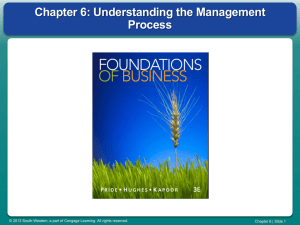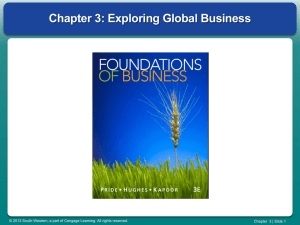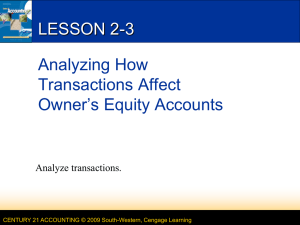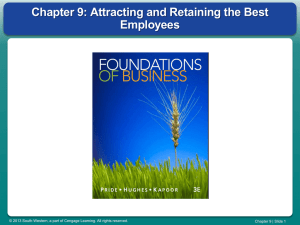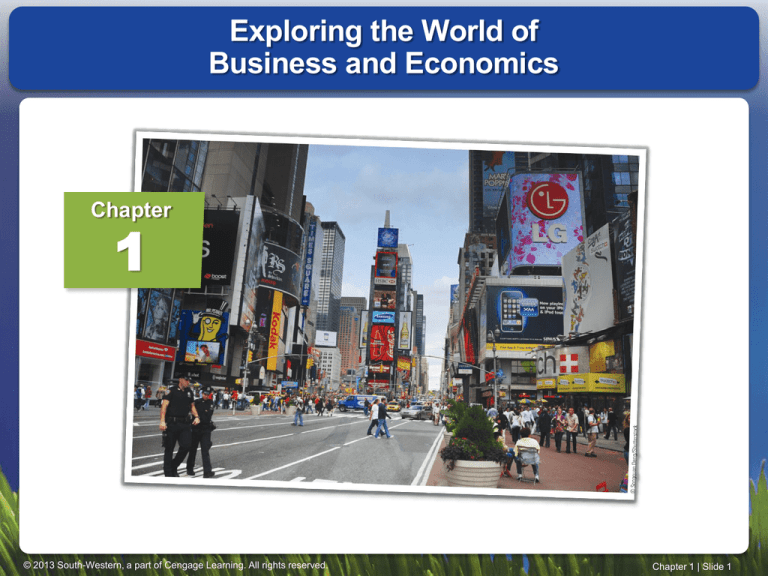
Exploring the World of
Business and Economics
Chapter
1
© 2013 South-Western, a part of Cengage Learning. All rights reserved.
Chapter 1 | Slide 1
Why Study Business?
For help in choosing a career
To be a successful employee
To improve your management skills
To start your own business
To become a better informed consumer and
investor
© 2013 South-Western, a part of Cengage Learning. All rights reserved.
Chapter 1 | Slide 2
Free Enterprise
“
…the system of business in which individuals
are free to decide what to produce, how to
produce it, and at what price to sell it.
-pg 4
“
© 2013 South-Western, a part of Cengage Learning. All rights reserved.
Chapter 1 | Slide 3
Business
“
…the organized effort
of individuals to
produce and sell, for a
profit, the goods and
services that satisfy
society’s needs.
-pg 10
“
© 2013 South-Western, a part of Cengage Learning. All rights reserved.
Chapter 1 | Slide 4
Combining Resources
© 2013 South-Western, a part of Cengage Learning. All rights reserved.
Chapter 1 | Slide 5
Business Profit
Sales Revenue
- Business Expenses
Profit (Loss)*
*Profit becomes the property of its owners
© 2013 South-Western, a part of Cengage Learning. All rights reserved.
Chapter 1 | Slide 6
Ultimate Objective of Every Firm
© 2013 South-Western, a part of Cengage Learning. All rights reserved.
“
“
…to satisfy the needs of its customers.
Chapter 1 | Slide 7
Stakeholders
“
“
…all the different people or groups
of people who are affected by the
policies, decisions, and activities
made by an organization.
-pg 12
Example: What if NewPage wanted to build a new mill in
Wisconsin Rapids? Who would be positively affected? Who
might be negatively affected?
© 2013 South-Western, a part of Cengage Learning. All rights reserved.
Chapter 1 | Slide 8
Economics
“
“
…the study of how wealth* is
created and distributed**.
-pg 12
* “anything of value,” including products
produced and sold by business
** “who gets what”
© 2013 South-Western, a part of Cengage Learning. All rights reserved.
Chapter 1 | Slide 9
Economy
“
…the decisions that individuals, business
firms, government, and society make.
The way in which people deal with the
creation and distribution of wealth
determines the kind of economic system,
or economy, that a nation has.
-pg 12
“
© 2013 South-Western, a part of Cengage Learning. All rights reserved.
Chapter 1 | Slide 10
2 Economic Perspectives
Microeconomics
The study of decisions made by:
• Individuals
• Businesses
Macroeconomics
The study of:
• National economy
• Global economy
© 2013 South-Western, a part of Cengage Learning. All rights reserved.
Chapter 1 | Slide 11
2 Types of Economic Systems
Capitalism
•
•
•
•
Free enterprise
Adam Smith (Wealth of Nations)
The invisible hand
Laissez-faire capitalism
Command
• Socialism
• Communism
– Karl Marx
© 2013 South-Western, a part of Cengage Learning. All rights reserved.
Chapter 1 | Slide 12
Adam Smith
Wealth of Nations (1776)
Society pursues self-interest
People work hard if:
• Earn more pay
• Earn more profit
Promotes good of community
© 2013 South-Western, a part of Cengage Learning. All rights reserved.
Chapter 1 | Slide 13
Basic Assumptions for Adam Smith’s
Laissez-Faire Capitalism
© 2013 South-Western, a part of Cengage Learning. All rights reserved.
Chapter 1 | Slide 14
“Invisible Hand”
“
…describes how an individual’s
own personal gain benefits others
and a nation’s economy.
-pg 13
“
Example: If a business is successful, think about
the different people or groups who benefit from
that.
© 2013 South-Western, a part of Cengage Learning. All rights reserved.
Chapter 1 | Slide 15
Capitalism
Individuals decide who owns and operates
the majority of businesses that
provide goods and services.
-pg 13
© 2013 South-Western, a part of Cengage Learning. All rights reserved.
Chapter 1 | Slide 16
Command Economy
The government decides what goods and
services will be produced, how they will be
produced, for whom available goods and
services will be produced, and who owns and
controls the major factors of production.
-pg 16
© 2013 South-Western, a part of Cengage Learning. All rights reserved.
Chapter 1 | Slide 17
2 Types of Command Economies
Socialism
Communism
© 2013 South-Western, a part of Cengage Learning. All rights reserved.
Chapter 1 | Slide 18
Socialism
Key industries are owned/controlled by government.
Land, buildings, and raw materials may be
property of state.
Private ownership is permitted to varying degrees.
People choose their own occupations.
National goals determine what is produced and how.
Uses taxes, rents, and wages to control distribution.
Examples: Most of the former USSR, Vietnam, even
China
© 2013 South-Western, a part of Cengage Learning. All rights reserved.
Chapter 1 | Slide 19
Communism
Karl Marx: Father
• Advocated classless society.
• Citizens own all economic resources.
• Workers contribute based on their ability and receive
benefits based on need.
Centralized planning to set prices and wages
Emphasis on government’s needs, not consumers’
No job choice; professionals better off than
factory workers
Examples: North Korea and Cuba
© 2013 South-Western, a part of Cengage Learning. All rights reserved.
Chapter 1 | Slide 20
U.S. = Mixed Economy
“
“
…an economy that exhibits elements
of both capitalism and socialism.
-pg 14
Other examples: France, Sweden, India are
transitioning to free market
© 2013 South-Western, a part of Cengage Learning. All rights reserved.
Chapter 1 | Slide 21
Circular Flow in Mixed Economy
© 2013 South-Western, a part of Cengage Learning. All rights reserved.
Chapter 1 | Slide 22
Measuring Economic Performance
Economic Indicators
• Gross domestic product (GDP)
–
•
•
•
•
•
The total value of all goods and services produced
by everyone in a country during a 1 year period
Inflation- general rise in prices
Deflation
Unemployment rate
Consumer price index (CPI)
– Index that measures the change in prices for food,
transportation, housing, clothing, medical care,
education etc.
Producer price index (PPI)
© 2013 South-Western, a part of Cengage Learning. All rights reserved.
Chapter 1 | Slide 23
Measuring Economic Performance (cont.)
Productivity rate
An economic measure that tracks the increase
and decrease in the average level of output
per worker
Unemployment rate
The percentage of a nation’s labor force
unemployed at any time
© 2013 South-Western, a part of Cengage Learning. All rights reserved.
Chapter 1 | Slide 24
GDP in Current Dollars and in
Inflation-Adjusted Dollars
© 2013 South-Western, a part of Cengage Learning. All rights reserved.
Chapter 1 | Slide 25
Measuring Economic Performance (contd)
From pg 19 of text.
© 2013 South-Western, a part of Cengage Learning. All rights reserved.
Chapter 1 | Slide 26
The Business Cycle
Fluctuations between periods
of growth and recession in a
nation’s economic activity.
-pg 20
Class Activity: Expert Groups for the 4 Phases of the
Business Cycle. You may use pgs 20-21 for help if
needed.
© 2013 South-Western, a part of Cengage Learning. All rights reserved.
Chapter 1 | Slide 27
States of the Business Cycle
Dow Jones
Peak
Peak
Recovery
Recession
Recession
Depression
Depression
1
2
3
Trough
4
5
6
7
8
9
10
11
Quarters
© 2013 South-Western, a part of Cengage Learning. All rights reserved.
Chapter 1 | Slide 28
Government Actions in Recession/Depression
Monetary Policy-the Federal Reserve
• the supply of money
• interest rates
Fiscal Policy-the Government
• Taxes
• Spending
© 2013 South-Western, a part of Cengage Learning. All rights reserved.
Chapter 1 | Slide 29
Federal Deficit
“
…a shortfall created when the
federal government spends more
in a fiscal year than it receives.
-pg 21
“
© 2013 South-Western, a part of Cengage Learning. All rights reserved.
Chapter 1 | Slide 30
Supply Curve and Demand Curve
© 2013 South-Western, a part of Cengage Learning. All rights reserved.
Chapter 1 | Slide 31
Four Different Types of Competition
© 2013 South-Western, a part of Cengage Learning. All rights reserved.
Chapter 1 | Slide 32
4 Types of Competition
1.
Perfect competition –pretty rare because it’s a
theoretical concept. Many buyers and Many sellers. No
one seller or buyer can influence market price. All must
accept the “going price.”Closest example would be a
large auction of identical goods with all potential buyers
and sellers present.
2.
Monopolistic competition-many buyers along with a
relatively large number of sellers. Products are VERY
similar and do the same things. Examples: shoes, soaps,
clothing, furniture.
Product differentiation
The process of developing and promoting differences between one’s products
and all competitive products
© 2013 South-Western, a part of Cengage Learning. All rights reserved.
Chapter 1 | Slide 33
4 Types of Competition (contd)
3.
Oligopoly Few sellers but they are big…Example: auto
industry, airlines, cereal makers. Actions of one seller
could effect price.
4.
Monopoly
Only one seller, and there are barriers to keep other
firms from entering the industry
• Natural monopoly: an industry that requires a huge
investment in capital and within which any duplication of
facilities would be wasteful– Example: Utilities-regulated because that is in the best
interest of the public
• Legal monopoly (limited monopoly): intellectual property
that is copyright protected
– Example: Microsoft with Microsoft Windows
© 2013 South-Western, a part of Cengage Learning. All rights reserved.
Chapter 1 | Slide 34
American Business Today
Early business development-the family
farm and “cottage industries”
• Business development in
the 1900s-the factory and specialization
• 2000 and beyond-the best of times
(technology advancements) and the
worst of times (recession and
uncertainty)
• The current business environment–
Competition (including global)
–
Technology
–
The economy
–
The environment
© 2013 South-Western, a part of Cengage Learning. All rights reserved.
Chapter 1 | Slide 35
Chapter Quiz
1. General Motors and Toyota are both
examples of
A.
B.
C.
D.
E.
marketing intermediaries.
manufacturers.
wholesalers.
international agents.
service businesses.
© 2013 South-Western, a part of Cengage Learning. All rights reserved.
Chapter 1 | Slide 36
Chapter Quiz
2. What remains after all business expenses
have been deducted from sales revenues
is
A.
B.
C.
D.
E.
cash.
excess return.
profit.
gross return.
operating revenue.
© 2013 South-Western, a part of Cengage Learning. All rights reserved.
Chapter 1 | Slide 37
Chapter Quiz
3. The total dollar value of all goods and
services produced by all people within the
boundaries of a country during a one-year
period is called
A.
B.
C.
D.
E.
gross manufacturing output.
gross domestic product (GDP).
real gross national product.
economic product.
national production report.
© 2013 South-Western, a part of Cengage Learning. All rights reserved.
Chapter 1 | Slide 38
Chapter Quiz
4. __________ is an economic system in which
individuals own and operate the majority of
businesses that provide goods and services.
A.
B.
C.
D.
E.
Bureaucratic economy
Command economy
Communism
Capitalism
Socialism
© 2013 South-Western, a part of Cengage Learning. All rights reserved.
Chapter 1 | Slide 39

